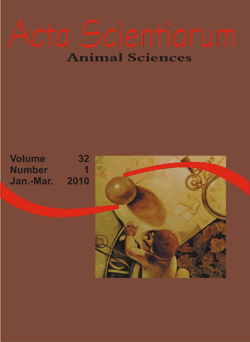<b>Preparation of Nile tilapia (<em>Oreochromis niloticus</em>) croquettes from MSM and ‘V’ cut fillet trim, and their physical, chemical, microbiological and sensory evaluation</b> - DOI: 10.4025/actascianimsci.v32i1.6909
Keywords:
breaded croquettes, fillet trim, proximate composition, organoleptic characteristics
Abstract
The objective of this study was to develop breaded croquettes using MSM and trim from ‘V” cut tilapia fillets. In the same study, physical-chemical and microbiological parameters were evaluated for raw materials and the ready croquettes, as well as a sensory analysis. For MSM, moisture was 79.05%, protein 14.63%, ash 0.87% and ether extract 4.66%; for the trim, 81.27, 14.53, 1.13 and 1.93%, respectively. For the pre-fried MSM croquettes, the values found were 57.93% moisture, 15.11% protein, 11.59% ash and 3.36% ether extract; for pre-fried trim croquettes, 57.84, 15.34, 9.17 and 3.95%, respectively. These parameters are within the current legislation for breaded products. The microbiological analysis of raw materials and pre-fried croquettes are within microbiological standards for foods. The sensory analysis showed that both croquettes were moderately accepted by tasters. Therefore, they can become an alternative to add value to fish by-products, with good consumer acceptance and meeting quality standards.Downloads
Download data is not yet available.
Published
2010-04-06
How to Cite
Bordignon, A. C., Souza, B. E. de, Bohnenberger, L., Hilbig, C. C., Boscolo, W. R., & Feiden, A. (2010). <b>Preparation of Nile tilapia (<em>Oreochromis niloticus</em>) croquettes from MSM and ‘V’ cut fillet trim, and their physical, chemical, microbiological and sensory evaluation</b> - DOI: 10.4025/actascianimsci.v32i1.6909. Acta Scientiarum. Animal Sciences, 32(1), 109-116. https://doi.org/10.4025/actascianimsci.v32i1.6909
Issue
Section
Animal Production
DECLARATION OF ORIGINALITY AND COPYRIGHTS
- I Declare that current article is original and has not been submitted for publication, in part or in whole, to any other national or international journal.
The copyrights belong exclusively to the authors. Published content is licensed under Creative Commons Attribution 4.0 (CC BY 4.0) guidelines, which allows sharing (copy and distribution of the material in any medium or format) and adaptation (remix, transform, and build upon the material) for any purpose, even commercially, under the terms of attribution.
Read this link for further information on how to use CC BY 4.0 properly.
0.9
2019CiteScore
29th percentile
Powered by 








































